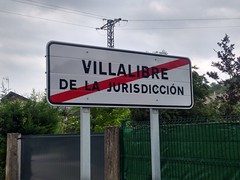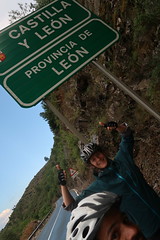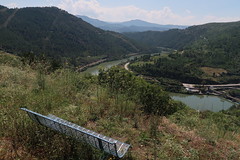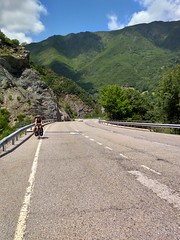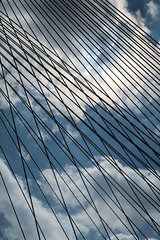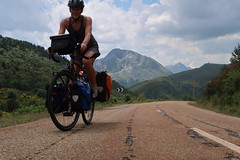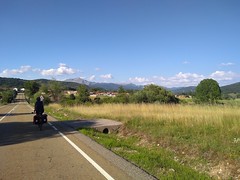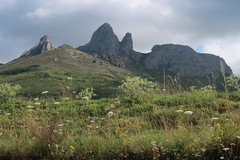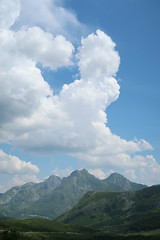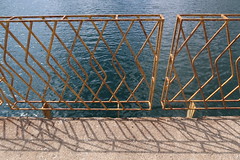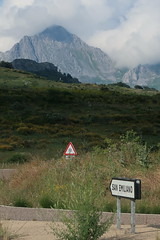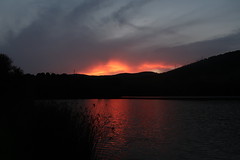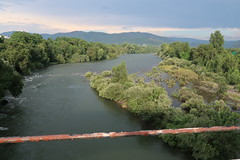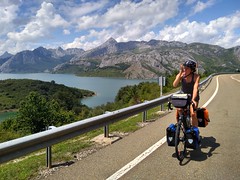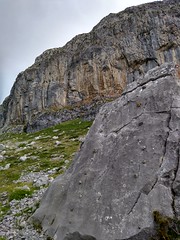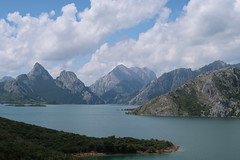Soon soon, the landscape changed – from fig trees and vegetable gardens to fields with animals grazing and mountains on the horizon. We were heading towards the Picos de Europa.
We said goodbye to the Rio Sil, just short of its source, and went on our way. We would pass along a section of road that we had cycled the previous year, but in the opposite direction, around La Luna Reservoir. Last year the reservoir had been so empty that you could see the ruined remains of the villages that had been flooded after the dam had been built and in other places there was nothing more than a trickle of river passing over a silty bed.
This year it was another story. Whilst folks in northern Europe have been getting unprecedented amounts of sunshine, here has been much more rainy than usual. The reservoir was so full that only the tree tops were exposed around the edges. The sailing club which last year had decamped several hundred metres away from their usual location to be close to the water, was this year back at their normal spot. We don’t like them though, they shooed us away when we tried to ask about hiring a kayak, snootily saying “Members only”.
With the increasing amount of rock in sight, Pedro started to regret not bringing his climbing gear. Discussions began as to whether it would be feasible to carry an extra bag of stuff, what would be the minimum amount of gear we would need, how much it would weigh and where we would get it from. Current estimates suggest that we could carry 50m of rope, 8 quickdraws, 2 pairs of shoes and 2 harnesses for 4.5kg… it’s tempting. The debate continues.
As we cycled on towards Riaño we passed many more reservoirs. With the sun reflecting on the water, and their bright blue contrasting with the mountains it was hard to get tired of the scenary.
We found it impossible to imagine what the landscape looked like before the dams were built and the reservoirs filled, and even more impossible to imagine what it must be like to live on the other side of one of those dams behind a wall nearly 100m high, holding back millions of tonnes of water. I don’t think I’d like to live there. The contrast from one side to the other is always stunning too – from giant watery reservoir on one side, to a small stream on the other.
After spending a morning climbing up to our highest point yet (Les Señales at 1625m), unsure as to whether the clouds would let us enjoy our lunch at the top, the clouds dispersed as we enjoyed our celebratory tortilla under the makeshift shade of our bikes.
Our goal was Maraña, where there was a small albergue that we could potentially stay the night. We free-wheeled down, cautiously at times past some cows that had taken to grazing on the road, and finally pulled up at the albergue, just as the heavens opened. The ladies of the albergue kindly let us pitch our tent in their back garden and we pottered around happy in the knowledge that there would be no alarm to get us up in the morning as for once we weren’t camping somewhere where we probably shouldn’t, and we were only 20km from our destination for the next day, Riaño.
The albergue will be a place to come back to for sure (Kilian, Marta and Gonçalo, take note – a point on the map for Picos 2020). Situated at the end of a no-through road, just past the main village and surrounded by mountains that we never did see the top of, bottles of sidre and climbing routes a plenty, it was quite hard to leave the next morning.







